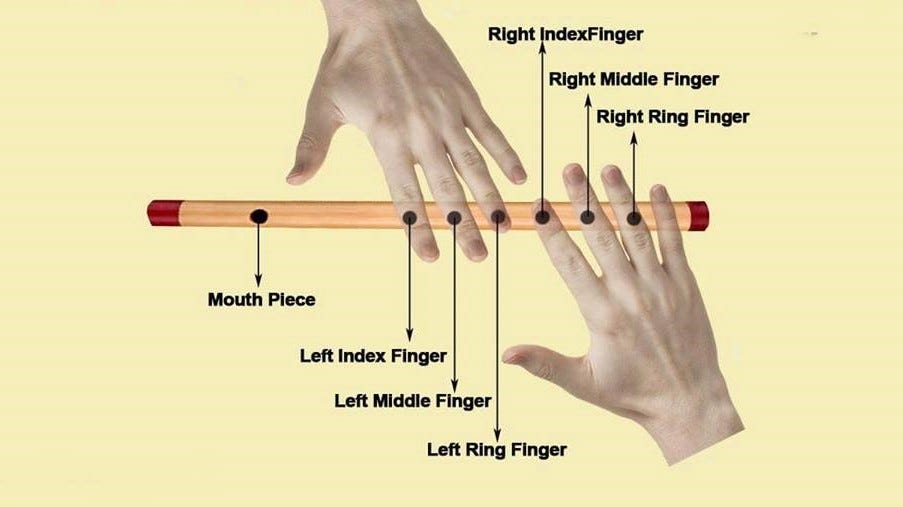1. Introduction: The Call of the Bansuri
Close your eyes. Imagine a quiet evening by the Yamuna river, the air filled with the hauntingly sweet sound of a bamboo flute. That’s the Bansuri – a simple hollow tube with six holes, yet capable of stirring deep emotions.
For centuries, this humble instrument has been the voice of Indian culture, from Krishna’s divine play to classical ragas and modern fusion. Fun fact: Did you know the Bansuri is one of the oldest instruments in the world?
👉 Love the sound of Bansuri? Listen to soulful Bansuri melodies on our Classical Melodies YouTube Shorts!
2. Mythological Roots: Krishna’s Flute of Love
The Divine Flute Player
The Bansuri isn’t just an instrument—it’s a symbol of divine love. In Hindu mythology, Lord Krishna’s flute (Murali/Venu) enchanted not just Radha and the Gopis, but even animals and rivers! The Bhagavata Purana describes how its music made the universe pause.
📜 “When Krishna plays his flute, time stands still.”

Ancient Texts & Early Evidence
- Natya Shastra (200 BCE – 200 CE): Bharata Muni mentions wind instruments like the Bansuri.
- Ajanta-Ellora Caves (2nd century BCE): Carvings depict flute players, proving its ancient roots.
🎥 Want to hear Krishna-inspired Bansuri tunes? Watch this short clip on Classical Melodies!
3. From Folk to Classical: The Bansuri’s Musical Journey
The Folk Connection
Before entering classical music, the Bansuri was a folk favorite:
- Punjab’s Algoza (twin flutes for fast beats)
- Rajasthan’s Murli (used in Manganiyar songs)
- Bengal’s Bashi (played in Baul music)
Rise in Classical Music
The Bansuri was initially seen as a pastoral instrument until legends like Pannalal Ghosh transformed it:
- Introduced longer flutes (bass Bansuri) for deeper notes.
- Made it a key instrument in Hindustani classical music.
🎶 Curious how classical Bansuri sounds? Check out this short performance!
4. The Golden Era: Bansuri Maestros Who Changed Music
Pannalal Ghosh: The Father of Modern Bansuri
He gave the Bansuri its classical identity, experimenting with scale variations.
Hariprasad Chaurasia: The Global Legend
- Trained under Pt. Annapurna Devi (daughter of Baba Allauddin Khan).
- Popularized Bansuri in world music (collabs with John McLaughlin, Zakir Hussain).
🔥 Watch a masterclass-level Bansuri solo here!
5. How a Bansuri is Made: Bamboo to Melody
The Perfect Bamboo
- Grown in Assam, Kerala, or the Western Ghats.
- Cured for months (sometimes years!) to avoid cracks.
Types of Bansuri
| Type | Pitch | Use |
|---|---|---|
| Bass (32+ inches) | Deep, meditative | Classical alap |
| Alto (22-26 inches) | Balanced | Raga performances |
| Soprano (14-18 inches) | High, lively | Folk/fast compositions |
🎋 See a Bansuri-making process in action on our YouTube Shorts!
6. Bansuri Today: From Bollywood to Healing
In Modern Music
- Bollywood Hits: “Piya Basanti” (Zubeidaa), “Albela Sajan” (Hum Dil De Chuke Sanam).
- Fusion & World Music: Remember Shakti’s jazz-Bansuri experiments?
Healing Powers
- Used in sound therapy (calms anxiety, improves focus).
- Meditation aid (its vibrations align with heart chakra).
🎧 Need relaxation? Try this soothing Bansuri track here.
7. Conclusion: Why the Bansuri is Eternal
From Krishna’s playful tunes to Chaurasia’s global concerts, the Bansuri remains India’s voice of the soul. Its simplicity hides infinite depth—just like India’s musical heritage.
💡 Want to keep exploring?
✅ Subscribe to Classical Melodies for daily Bansuri magic!
✅ Learn Bansuri? Start with our beginner-friendly shorts!
